Solved Examples
Example 37.1 A bar magnet made of steel has a magnetic moment of 2.5 A–m2 and a mass of 2.5 A–m2
and a mass of 6.6 × 103 kg. If the density of steel is 7.9 × 10 3 kg/m3 , find the intensity
of magnetization of the magnet.
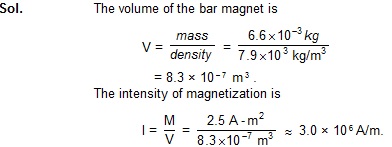
Example 37.2 Find the magnetic intensity H at the centre of a long solenoid having n turns per unit
length and carrying a current i
(a) when no material is kept in it and
(b) when a long copper rod is inserted in the solenoid.
Sol.

(b) As the solenoid and the rod are long and we are interested in the magnetic intensity at the centre,
the end effects may be neglected. There is no effect of the rod on the magnetic intensity at the centre.
Its value in both cases are the same. Thus H = ni.
Example 37.3 Find the per cent increase in the magnetic field B when the space withhin a
current–carrying toroid is filled with aluminium. The susceptibility of aluminium is 2.1 × 10 – 5 .
Sol. 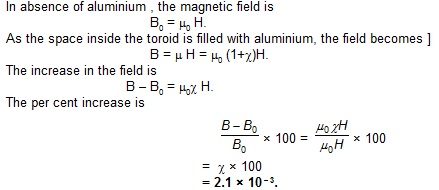
Questions for Short answer
Objective - I
1. A perpendicular material is place in a magnetic fields. Consider the following statemetns;
(A) If the magnetic field is increased, the magnetization is increased.
(B) If the temperature is increased, the magnetization is increased
(A) Both A and B are true (B) A is true but B is false
(C) B is true but A is false (D) Both A and B are false
2. A paramagnetic material is kept in a magnetic field. The field is increased till the magnetization
becomes constant. If the temperature is now decreased, the magnetization
(A) will increase (B) decrease (C) ramain constant (D) may increase of decrease
3. A ferromagnetic material is placed in an external magnetic field. The magnetic domains
(A) increase in size (B) decrease in size
(C) may increase or decrease is size (D) have no relation with the field
4. A long, straight wire carries a current i. The magnetizing field intensity H is measured at a
point P close to the wire. A long, cylindrical iron rod is brought close to the wire so that the
point P is at the centre of the rod. The value of H at P will
(A) increase many times (B) decrease many times
(C) remain almost constant (D) become zero
5. The magnetic susceptibility is negative for
(A) paramagnetic materials only (B*) diamagnetic material only
(C) ferromagnetic materials only (D) paramagnetic and ferromagnetic materials
6. The desirable properties for making permanent magnets are
(A) high retentivity and high coercive force (B) high retentivity and low coercive force
(C) low retentivity and high coercive force (D) low retentivity and low coercive force
7. Electromagnets are made of soft iron because soft iron has
(A) high retentivity and high coercive force (B) high retentivity and low coercive force
(C) low retentivity and high corecive force (D*) low retentivity and low coercive force
Objective - II
1. Pick the correct options
(A) All electrons have magnetic moment (B) All protons have magnetic moment
(B) All nuclei have magnetic moment (D) All atoms have magnetic moment
2. The permaent magnetic moment of the atoms of a material is not zero. The material
(A) must be paramagnetic (B) must be diamagnetic
(C) must be ferromagnetic (D) may be paramagnetic
3. The permanent magnetic of the atoms of a material is not zero. The material
(A) must be paramagnetic (B) must be diamagnetic
(C) must be ferromagnetic (D) may be paramagnetic
4. Which of the following pairs has quantities of the same dimension ?
(A) magnetic field B and magnetizing field intensity H
(B) magnetic field B and intensity of magnetization I
(C) magnetic field intensity H and intensity of magnetization I
(D) longitudinal strain and magnetic susceptibility
5. When a ferromagnetic material goes through a hysteresis loop, the magnetic susceptibility
(A) has a fixed value (B) may be zero (C) may be infinity (D) may be negative
6. Mark out the correct options.
(A) Diamagnetism occurs in all materials
(B) Diamagnetism result from the partial alignment of perpmanent magnetic moment.
(C) The magnetizing field intensity H is always zero in free space
(D) The magnetic field of induced magnetic moment is opposite to the applied field.
Worked Out Examples
1. A tighty-wound , long solenoid having 50 turns/cm , carries a current of 4.00 A .
Find the magnetic intensity H and the magnetic field B at the centre of the solenoid.
What will be the values of these quantities if an iron core is inserted in the solenoid
and the magnetization I in the core is 4.00 × 106 A/m ?
Sol.

It should be noted that the magnetic intensity H is very small as compared to the magnetization
I in presence of the iron core.
2. A long cylindrical iron core of cross-sectional area 5.00 cm2 is inserted into a long solenoid
having 2000 turns/m and carrying a current 2.00 A . The magnetic field inside the core is
found to be 1.57 T. Neglecting the end effects , find the magnetization I of the core and the
pole strength developed.
Sol.
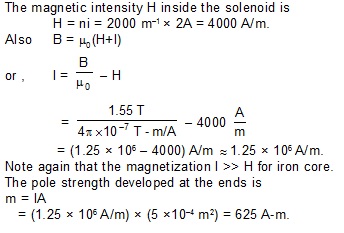
3. An ideal solenoid having 40 turns/cm has an aluminimum core and carries a current of 2.0 A.
Calculate the magnization I developed in the core and the magnetic field B at the centre,
The susceptibility of aluminimum = 2.3 × 10–5 .
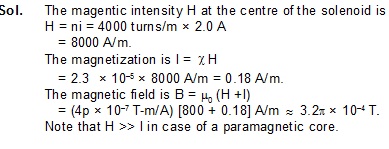
4. Find (a) the magnetization I , (b) the magnetic intensity H and (c) the magnetic field B at the
centre of a bar magnet having pole strength 3.6 A-m , magnetic length 12 cm and cross-sectional area 0.90 cm2.
Sol.
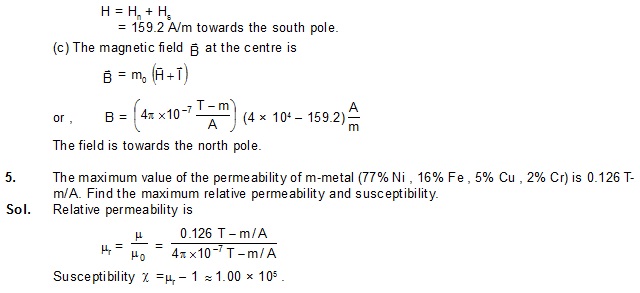
6. A toroid has a mean radius R equal to 20/pie cm, and a total of 400 turns of wire carrying a current of 2.0A.
An aluminimum ring at temperature 280 K inside the toroid provides the core. (a) if the magnetization I is
4.8 × 10–2 A/m , find the susceptibility of aluminimum at 280 K. (b) If the temperature of the aluminimum
ring is raised to 320 K. What will be the magnization ?
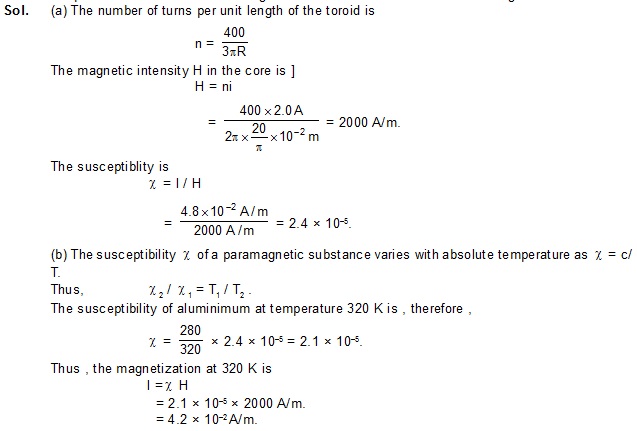
QUESTIONS FOR SHORT ANSWER
1. When a dielectri is placed in an electric field , it gets polarized. The electric field in a polarized material is less than
the applied field. When a paramagnetic substance is kept in a magnetic field , the field in the substance is more than
the applied field. Explain the reason of this opposite behaviour.
2. The property of diamagnetism is said to be present in all materials. Then , why are some materials paramagnetic or ferromagnetic ?
3. Do permeability and relative permeability have the same dimensions ?
4. A rod when suspended in a magnetic field stays in east-west direction. Can we be sure that the field is in the
east-west direction ? Can it be in the north-south direction ?
5. Why cannot we make permanent magnets from paramagnetic materials ?
6. Can we have magnetic hysteresis in paramagnetic or diamagnetic substance ?
7. When a ferromagnetic material goes through a hysteresis loop , its thermal energy is increased. Where does this energy come from ?
8. What are the advantages of using soft iron as a core , instead of steel , in the coils of galvanometers ?
9. To keep valuable instruments away from the earth’s magnetic field , they are enclosed in iron boxes. Explain.
Exercise
1. The magnetic intensity H at the centre of a long solenoid carrying a current of 2.0 A, is found to be 1500 A/m.
Find the number of turns per centimeter of the solenoid.
Ans.7.5
2. A rod is inserted as the core in the current-carrying solenoid of the previous problem.
(a) what is the magnetization intensity H at the centre?
(b) If the magnetization I of the core is found to be 0.12 A/m,
find the acceptability of the material of the rod.
(c) Is the material paramagnetic, diamagnetic or ferromagnetic ?
Ans: (a) 1500 A/m (b) 8.0 × 10–5 (c) paramagnetic
3. The magnetic field inside a long solenoid having 50 turns/cm is increased from 2.5 × 10 – 3 T when an
iron core of cross-sectional area 4cm 2 is inserted into it .Find (a) the current in the solenoid ,
(b) the magnetization I of the core and (c) the pole strength developed in the core.
Ans: (a) 0.4A (b) 2.0 × 10 6 A/m (c) 800 A–m
4. A bar magnet of length 1cm and cross-section a l area 1.0 cm 2 produces a magnetic field of 1.5 × 10 – 4 T
at point in end- on position at a distance 15cm away from the centre. (a) Find the magnetic moment M of the magnet.
(b) Find the magnetization I of the magnet. (c) Find the magnetic field B at the centre of the magnet.
Ans: (a) 2.5 A–m2 (b) 2.5 × 10 6 A/m (c) 1.2T
5. The susceptibility of annealed iron at saturation is 5500. Find the permeability of annealed iron at saturation .
Ans: 6.9 × 10 – 3
6. The magnetic field B and magnetic intensity H in a material are found to be 1.6 T and 1000. A/m respectively.
Calculate the relative permeability µ1 and the susceptibility x of the material.
Ans: 1.3 × 10 3
7. The susceptibility of magnesium at 300 K is 1.2 × 10–5 . At what temperature will the susceptibility increase to 1.8 × 10–5 ?
8. Assume that each iron atom has a permanent magnetic moment equal to 2 Bohr magnetons (1Bohr magneton equals 9.27 × 10 –24 A –m2).
The density of atoms in iron is 8.52 × 10 28 atom/m
(a) Find the maximum magnetization i in a long cylinder of iron. (b). Find the maximum magnetic field B on the axis inside the cylinder.
Ans: 200K
9. The coercive force for a certain permanent magnet is 4.0 × 10 A/m. This magnet is placed inside a long solenoid of 40 turns/cm and
a current is passed in the solenoid of demagnetise it completely. Find the current .
Ans: 10 A